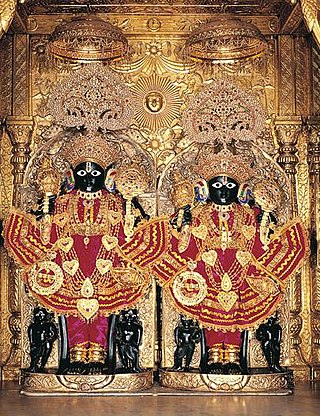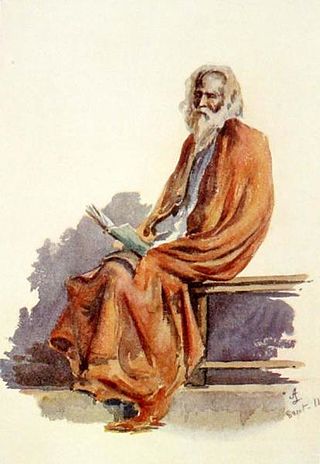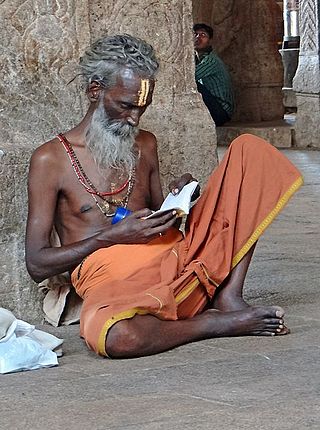
Dharma is a key concept in the Indian religions of Hinduism, Buddhism, Jainism and Sikhism. The term dharma is held as an untranslatable into English ; it is understood to refer to behaviours which are in harmony with the "order and custom" that sustains life; "virtue", righteousness or "religious and moral duties". The antonym of dharma is adharma.

Bhrigu is a rishi of Adi-rishi tradition. He is one of the seven great sages, the Saptarshis, and one of the many Prajapatis created by Brahma. The first compiler of predictive astrology and also the author of Bhrigu Samhita, an astrological (jyotisha) classic. Bhrigu is considered a manasaputra ("mind-born-son") of Brahma. The adjectival form of the name, Bhārgava, is used to refer to the descendants and the school of Bhṛgu. According to Manusmriti, Bhṛgu was a compatriot of and lived during the time of Svāyambhuva Manu, the progenitor of humanity. Along with Manu, Bhṛgu had made important contributions to the Manusmṛti, which was constituted out of a sermon to a congregation of saints in the state of Brahmavarta, after the great floods in this area. As per the Skanda Purana, Bhṛgu migrated to Bhrigukaccha, modern Bharuch, on the banks of the Narmada river in Gujarat, leaving his son Chyavana at Dhosi Hill.
Smṛti, also spelled smriti, smruti, is a body of Hindu texts representing the remembered, written tradition in Hinduism, rooted in or inspired by the Vedas. Smṛti works are generally attributed to a named author and were transmitted through manuscripts, in contrast to Vedic or śruti literature, which is based on a fixed text with no specific author, and preserved through oral transmission. Smṛti are derivative, secondary works and considered less authoritative than śruti in Hinduism, except in the Mīmāmsa school of Hindu philosophy. The authority of smṛti accepted by orthodox schools is derived from that of śruti, on which it is based.
Brahmacharya is a concept within Indian religions that literally means "conduct consistent with Brahman" or "on the path of Brahman". Brahmacharya, a discipline of controlling the senses, is seen as a way to liberation. Though sexual restraint is a part of brahmacharya, brahmacharya encompasses all striving toward a passionless state.

Vānaprastha literally meaning 'way of the forest' or 'forest road', is the third stage in the 'Chaturasrama' system of Hinduism. It represents the third of the four ashramas (stages) of human life, the other three being Brahmacharya, Grihastha and Sannyasa.

Sannyasa, sometimes spelled sanyasa, is the fourth stage within the Hindu system of four life stages known as ashramas, the first three being brahmacharya, grihastha (householder) and vanaprastha. Sannyasa is traditionally conceptualized for men or women in the last years of their life, but young brahmacharis have the choice to skip the householder and retirement stages, renounce worldly and materialistic pursuits and dedicate their lives to spiritual pursuits.

Naranarayana, also rendered Nara-Narayana, is a Hindu duo of sage-brothers. Generally regarded to be the partial-incarnation (aṃśa-avatara) of the preserver deity, Vishnu, on earth, Nara-Narayana are described to be the sons of Dharma and Ahimsa.
Purushartha literally means "object(ive) of men". It is a key concept in Hinduism, and refers to the four proper goals or aims of a human life. The four puruṣārthas are Dharma, Artha, Kama and Moksha.
The following list consists of notable concepts that are derived from Hindu culture and associated cultures’ traditions, which are expressed as words in Sanskrit or other Indic languages and Dravidian languages. The main purpose of this list is to disambiguate multiple spellings, to make note of spellings no longer in use for these concepts, to define the concept in one or two lines, to make it easy for one to find and pin down specific concepts, and to provide a guide to unique concepts of Hinduism all in one place.
Santosha literally means "contentment, satisfaction". It is also an ethical concept in Indian philosophy, particularly Yoga, where it is included as one of the Niyamas by Patanjali.
Āśrama is a system of stages of life discussed in Hindu texts of the ancient and medieval eras. The four asramas are: Brahmacharya (student), Gṛhastha (householder), Vanaprastha, and Sannyasa (renunciate).

The Adi Parva or The Book of the Beginning is the first of eighteen books of the Mahabharata. "Ādi" in Sanskrit means "first".

Sabha Parva, also called the "Book of the Assembly Hall", is the second of eighteen books of Mahabharata. Sabha Parva traditionally has 10 parts and 81 chapters. The critical edition of Sabha Parva has 9 parts and 72 chapters.
The Samavartana, also known as Snāna, is a rite of passage in the ancient texts of Hinduism. Performed at the close of the Brahmacharya period, it marks the graduation of a student from Gurukul (school). It signifies a person's readiness to enter grihastashrama.
Akrodha literally means "free from anger". It's an important virtue in Indian philosophy and Hindu ethics.

Aruneya Upanishad is a minor Upanishad in the corpus of the 108 Upanishads of Hinduism. It is written in Sanskrit. It is one of the 16 Upanishads attached to the Samaveda. It is classified as a Sannyasa Upanishad.

The Jabala Upanishad, also called Jabalopanisad, is a minor Upanishad of Hinduism. The Sanskrit text is one of the 20 Sannyasa Upanishads, and is attached to the Shukla Yajurveda.

The Naradaparivrajaka Upanishad is a medieval era Sanskrit text and one of the minor Upanishads of Hinduism. The text is attached to the Atharva Veda, and is one of the 20 Sannyasa (renunciation) Upanishads.
In Hinduism, Śāstra pramāṇam refers to the authority of the scriptures with regard to puruṣārtha, the objects of human pursuit, namely dharma, artha, kāma (pleasure) and mokṣa (liberation). Together with smṛti, ācāra, and ātmatuṣṭi, it provides pramana and sources of dharma, as expressed in Classical Hindu law, philosophy, rituals and customs.
Riddles in Hinduism is an English language book by the Indian social reformer and political leader B. R. Ambedkar, aimed at enlightening the Hindus, and challenging the sanatan (static) view of Hindu civilization circulated by "European scholars and Brahmanic theology". Ambedkar quotes various Hindu texts to criticize the "Brahmanic theology" of Hinduism. He discusses a variety of topics, including the contents, the authority, and the origin of the Hindu texts such as the Vedas; the absurdities, the contradictions, and the changing nature of the Hindu beliefs; and the discriminatory varna and the caste system, among other topics. The title of the book refers to questions ("riddles") that Ambedkar asks at the end of each chapter, encouraging the reader to think for themselves.









